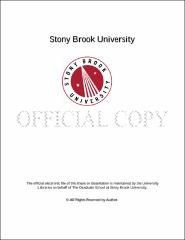| dc.identifier.uri | http://hdl.handle.net/11401/77619 | |
| dc.description.sponsorship | This work is sponsored by the Stony Brook University Graduate School in compliance with the requirements for completion of degree. | en_US |
| dc.format | Monograph | |
| dc.format.medium | Electronic Resource | en_US |
| dc.language.iso | en_US | |
| dc.publisher | The Graduate School, Stony Brook University: Stony Brook, NY. | |
| dc.type | Dissertation | |
| dcterms.abstract | The specificity of encapsidation of members of the genus Enterovirus of the Picornaviridae family depends on an interaction between capsid proteins and nonstructural protein 2CATPase. In particular, in the context of a chimeric virus, the N252 residue of poliovirus (PV) 2CATPase interacts with VP3 E180 of coxsackievirus A20. PV 2CATPase has important roles both in RNA replication and encapsidation, but in the context of just the poliovirus polyprotein, N252 does not function in assembly. The aim of my study was to search for additional residues near N252 in 2CATPase that are required for PV encapsidation. I predicted a three-dimensional protein structure of PV 2CATPase to assist in the selection of residues used for mutagenesis. Accordingly, segments adjacent to N252 were genetically analyzed by combining triple and single alanine mutations to identify individual residues required for function. From four triple alanine mutants, two exhibited defects in RNA replication. The remaining two mutations, located in secondary structures in a predicted three-dimensional model of 2CATPase, caused lethal growth phenotypes. Most single alanine mutants, derived from the lethal triple variants, were either quasi-infectious and yielded variants with wildtype (wt) or ts growth phenotypes or had a lethal growth phenotype due to a defect in RNA replication. However, a virus harboring a K259A mutation, mapping to an alpha helix in the predicted protein structure of 2CATPase near N252, replicated with wt kinetics at 37oC, but resulted in a cold-sensitive virus at 33oC. In vivo protein synthesis and virus production were strikingly delayed at 33oC relative to the wt suggesting a defect in uncoating. Studies with a reporter virus indicated that this mutant is also defective in encapsidation at 33OC. Cell imaging confirmed a much-reduced production of K259A mature virus at 33oC relative to the wt. In conclusion, we have identified a new residue in PV 2CATPase (K259A) that is involved in particle assembly. In addition, we have linked a cold sensitive encapsidation defect mapping to 2CATPase (K259A) to a subsequent delay in uncoating of the virus particle during the next cycle of infection at 33oC. | |
| dcterms.available | 2017-09-20T16:53:02Z | |
| dcterms.contributor | Carter, Carol | en_US |
| dcterms.contributor | Wimmer, Eckard | en_US |
| dcterms.contributor | Hearing, Patrick | en_US |
| dcterms.contributor | Krug, Laurie | en_US |
| dcterms.contributor | Rieder, Elizabeth. | en_US |
| dcterms.creator | Asare, Emmanuel Noble | |
| dcterms.dateAccepted | 2017-09-20T16:53:02Z | |
| dcterms.dateSubmitted | 2017-09-20T16:53:02Z | |
| dcterms.description | Department of Genetics. | en_US |
| dcterms.extent | 137 pg. | en_US |
| dcterms.format | Application/PDF | en_US |
| dcterms.format | Monograph | |
| dcterms.identifier | http://hdl.handle.net/11401/77619 | |
| dcterms.issued | 2015-12-01 | |
| dcterms.language | en_US | |
| dcterms.provenance | Made available in DSpace on 2017-09-20T16:53:02Z (GMT). No. of bitstreams: 1
Asare_grad.sunysb_0771E_12463.pdf: 27476512 bytes, checksum: d94414b869845fdad7adc4c8af962691 (MD5)
Previous issue date: 1 | en |
| dcterms.publisher | The Graduate School, Stony Brook University: Stony Brook, NY. | |
| dcterms.subject | 2CATPase, Poliovirus | |
| dcterms.subject | Genetics | |
| dcterms.title | Genetic and structural analyses of poliovirus protein 2CATPase | |
| dcterms.type | Dissertation | |

